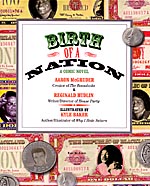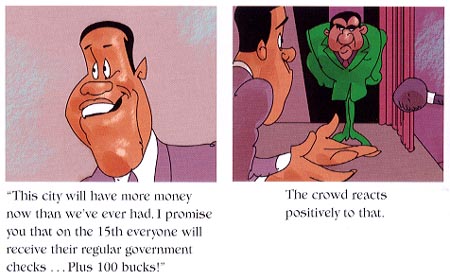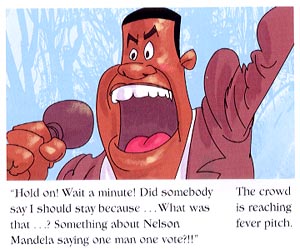 Written by Aaron McGruder and Reginald Hudlin
Written by Aaron McGruder and Reginald Hudlin
Art by Kyle Baker
144 pages, color
Published by Crown Publishers
I absolutely love Aaron McGruder’s comic strip The Boondocks. When I heard that McGruder was co-writing a graphic novel with Reginald Hudlin (screenwriter for the movie House Party), I was excited. When I heard that Kyle Baker (Why I Hate Saturn, The Cowboy Wally Show) was illustrating it, I was ecstatic. And when I got my hands on the book, well… good times were definitely here. It’s tough for something to live up to high expectations, but it’s even harder for it to exceed them. And that is exactly what Birth of a Nation did.
In the 2000 Presidential Election, the people of East St. Louis, Illinois were routinely turned away from polls for a variety of fictitious reasons, the state’s electoral votes going to Governor Caldwell and giving him the presidency. When the people of East St. Louis are told that their voting rights were illegally taken away from them, but that Caldwell would still become president, they got mad. And then they decided to take action. But can the run down city of East St. Louis really secede from the United States and become its own nation?

It’s easy to see where McGruder and Hudlin got their inspiration for Birth of a Nation from, thinly disguising the real events of the 2000 election. As Hudlin’s introduction to the book explains, though, those are hardly the only events that are based on reality in Birth of a Nation. He and McGruder wisely set their graphic novel in East St. Louis because this decaying city really does exist, and it really is in such dire straits. Readers of Dennis O’Neil’s The Question for DC Comics will be familiar with East St. Louis (it’s what the fictitious Hub City was based on) and its problems, from garbage strikes to rampant corruption and unemployment. McGruder and Hudlin show a city of people who don’t have very much, but still rebel when their rights as citizens of the United States are taken away from them, and from that moment on you find yourself with a great deal of respect for them. While many of the characters prove themselves to be admirable early on, like Mayor Fredericks who tries to do right for his constituents, it’s impressive how the city is able to rise up, together, and make a stand.Of course, Birth of a Nation is also awfully funny. There’s a lot of humor and satire here, from jokes about the oil companies controlling the world, to the most dangerous General in the new nation’s military trying to prove himself worthy of the job. As the story progresses, it does so in a logical fashion, each new piece building on what happened before. Even as money woes strike at Blackland (the story of how the name for the country comes about is amusing enough that I won’t explain it here), solutions arrive in a way that makes perfect sense in today’s world. By the end of Birth of a Nation, you can’t help but be impressed with how tightly crafted McGruder and Hudlin’s script is. The Boondocks makes me laugh on a regular basis and House Party is a pretty funny movie, but Birth of a Nation is the sharpest creation I’ve seen the two of them work on.
 Baker’s art for Birth of a Nation both does and does not work for me. I really like his individual illustrations, as each one is paired with a caption or dialogue beneath it. Baker’s art style at a casual glance looks whimsical, with its cartoonish faces and expressions, but he’s able to shift over to serious in an instant as the story demands. This is also probably the nicest color art I’ve seen from Baker; the color gradients help give the art a lot of depth without looking out of place. It almost goes without saying that Birth of a Nation has the best range of darker skin tones that I can remember seeing in comics; it’s great to see a graphic novel that remembers that you should have more than one color value for “black skin”. The one thing I don’t like about Baker’s art, though, is the lack of sequential art. Panels never seem to really lead into one another, instead all serving as self-contained images that could just as easily be shuffled across the page at random. Moving from one image to the next, you almost never get a feeling of any real sort of progression. It’s less like you’re reading a comic and more like a book of movie storyboards. There are several instances where captions below the art explain reactions or events that the art should have depicted. Instead of having a single large panel with a static image talking about a crowd which suddenly erupts into booing, why not put two panels in there that actually show the crowd’s reaction as they move into action? It’s this lack of storytelling in Birth of a Nation that’s a little frustrating; I’m not sure if it’s a problem of a script that didn’t have confidence in the art to tell the story, or if the art just didn’t provide the needed transitions and the script had to make up for it. Either way it falls down on that part of its duties. It’s an unfortunate stumble in an otherwise excellent book.
Baker’s art for Birth of a Nation both does and does not work for me. I really like his individual illustrations, as each one is paired with a caption or dialogue beneath it. Baker’s art style at a casual glance looks whimsical, with its cartoonish faces and expressions, but he’s able to shift over to serious in an instant as the story demands. This is also probably the nicest color art I’ve seen from Baker; the color gradients help give the art a lot of depth without looking out of place. It almost goes without saying that Birth of a Nation has the best range of darker skin tones that I can remember seeing in comics; it’s great to see a graphic novel that remembers that you should have more than one color value for “black skin”. The one thing I don’t like about Baker’s art, though, is the lack of sequential art. Panels never seem to really lead into one another, instead all serving as self-contained images that could just as easily be shuffled across the page at random. Moving from one image to the next, you almost never get a feeling of any real sort of progression. It’s less like you’re reading a comic and more like a book of movie storyboards. There are several instances where captions below the art explain reactions or events that the art should have depicted. Instead of having a single large panel with a static image talking about a crowd which suddenly erupts into booing, why not put two panels in there that actually show the crowd’s reaction as they move into action? It’s this lack of storytelling in Birth of a Nation that’s a little frustrating; I’m not sure if it’s a problem of a script that didn’t have confidence in the art to tell the story, or if the art just didn’t provide the needed transitions and the script had to make up for it. Either way it falls down on that part of its duties. It’s an unfortunate stumble in an otherwise excellent book.
Birth of a Nation was a strong enough graphic novel that I’ll say right now that if McGruder, Hudlin, and Baker collaborate again I’m definitely going to buy that project sight unseen. Birth of a Nation is funny, it’s serious, and all points in-between. Hopefully Crown Publishers (which is part of the Random House publishing empire) will get Birth of a Nation into all the right hands, because it deserves to be seen by many. Whether it’s talking about the rights of United States citizens or the prospect of putting Will Smith’s face on the dime, Birth of a Nation succeeds admirably in entertaining its audience.
Purchase Links:
